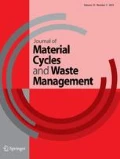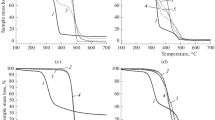Abstract
Irradiation cross-linked polyethylene (PEX) and irradiation cross-linked polyethylene with carbon black filler (CB-PEX) are two types of scraps, generated in electric cable production. Their pyrolysis is studied in this work using instrumental TG\DSC\FTIR techniques and kinetic analysis. The experiments are performed at a constant heating rate of 10 °C/min in nitrogen flow at atmospheric pressure. It is found that the main pyrolysis stage is in the temperature range of 395–503 °C for PEX, and in range of 408–515 °C for CB-PEX. In the main pyrolysis stage, CB-PEX requires more external heat than PEX does. Olefins are the major products of pyrolysis for both materials, but they are quite different in their composition and molecular weight distribution. PEX can be converted almost quantitatively into volatile compounds. CB-PEX has a stronger coking tendency, as well as a larger residue composed of carbon black.




Similar content being viewed by others
References
Dufton PW (1995) Recent development in polymer for wire and cable: An insulation report, Rapra Technology Ltd, UK
Rado R, Zelenak P (1992) Crosslinking of polyethylene. Int Polym Sci Tech 19(6):33–47
Bostrom J, Gustafsson B, Lindbom L (1997) XLPE compound for fast cable line speed. Electr Insul Mag IEEE 13(5):33–36
Narkis M, Ram A, Stein Z (1980) Effect of crosslinking on carbon black/polyethylene switching materials. J Appl Polym Sci 25(7):1515–1518
Burns Jr NM, Reid CG (2000) Cable semiconducting shields, Google Patents
Wang MJ et al. (2003) Carbon black. Encyclopedia of polymer science and technology
Seki S, Yoshioka T (2015) Recycling of PVC pipes and fittings in Japan: proactive approach of industry to and its impacts on legal/technical frameworks. J Mater Cycles Waste Manag, p 1–11
Tamboli SM, Mhaske ST, Kale DD (2004) Crosslinked polyethylene. Indian J Chem Technol 11(6):853–864
Tokuda S et al (2003) Thermoplasticizing technology for the recycling of crosslinked polyethylene. Furukawa Rev 23:88–93
Shang L et al (2011) Pyrolyzed wax from recycled cross-linked polyethylene as warm mix asphalt (WMA) additive for SBS modified asphalt. Constr Build Mater 25(2):886–891
Ogunseitan OA et al (2009) The electronics revolution: from e-wonderland to e-wasteland. Science 326(5953):670
Ibarra RM et al (2015) Carbon fiber recovery using water and benzyl alcohol in subcritical and supercritical conditions for chemical recycling of thermoset composite materials. J Mater Cycles Waste Manage 17(2):369–379
Okajima I, Sako T (2015) Recycling of carbon fiber-reinforced plastic using supercritical and subcritical fluids. J Mater Cycles Waste Manag, p 1–6
Donaj PJ et al (2012) Pyrolysis of polyolefins for increasing the yield of monomers’ recovery. Waste Manag 32(5):840–846
Al-Salem SM, Lettieri P, Baeyens J (2010) The valorization of plastic solid waste (PSW) by primary to quaternary routes: from re-use to energy and chemicals. Prog Energy Combust Sci 36(1):103–129
Roumeli E et al. (2013) Carbon nanotube-reinforced crosslinked polyethylene pipes for geothermal applications: From synthesis to decomposition using analytical pyrolysis–GC/MS and thermogravimetric analysis. Polym Degrad Stab
Marcilla A et al (2006) Thermal and catalytic pyrolysis of crosslinked polyethylene. J Anal Appl Pyrol 76(1):254–259
Buekens A (2006) Introduction to feedstock recycling of plastics. Feedstock Recycl Pyrolysis Waste Plast, p 1–41
Du Y et al (2013) Evaluation of cofiring bioferment residue with coal at different proportions: combustion characteristics and kinetics. Energy Fuels 27(10):6295–6303
Acknowledgments
The Project was supported by the National Basic Research Program (973 Program) of China (No. 2011CB201500), the Research Project of environmental protection commonweal industry (201209023-4), National High Technology Research and Development Program of China (863 Program, 2012AA063505), Zhejiang University President Special Fund (585100-172210331), the Program of Introducing Talents of Discipline to University (B08026). Special thanks go to Prof. Toshiaki Yoshioka and Dr. G. Grause (Tohoku University) for suggestions and advice.
Author information
Authors and Affiliations
Corresponding author
Rights and permissions
About this article
Cite this article
Du, Y., Jiang, X., Lv, G. et al. TG-DSC and FTIR study on pyrolysis of irradiation cross-linked polyethylene. J Mater Cycles Waste Manag 19, 1400–1404 (2017). https://doi.org/10.1007/s10163-016-0530-z
Received:
Accepted:
Published:
Issue Date:
DOI: https://doi.org/10.1007/s10163-016-0530-z




